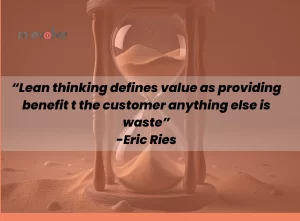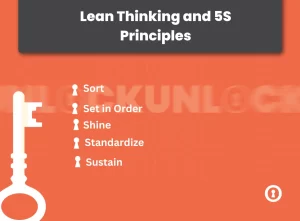
Introduction:
In the world of today’s business, it is essential to streamline work processes as much as possible, thus reducing waste and improving productivity in the process. Lean thinking, which is a methodology rooted in efficiency and continuous improvement, along with the 5S principles, which form a fundamental aspect of Lean, offer a structured approach to achieving these goals.
In this blog, we’ll explore the concept of Lean thinking and 5S principles, providing you with a comprehensive guide to transform your workplace into a model of efficiency and effectiveness.
Understanding Lean Thinking and 5S Principles:
At its core, Lean thinking is an organizing philosophy that revolves around maximizing customer value while minimizing waste. Though they were originally derived from the Toyota Production System, these lean principles have found applications in various industries worldwide. The fundamental idea is to eliminate activities that do not add value to the customer, focusing on continuous improvement, respect for people, and the relentless pursuit of perfection.
Now, you must be wondering, What about the 5S of the workplace? The 5S principles are a cornerstone of Lean thinking, and they provide a systematic approach to workplace organization and standardization. The 5S’s stand for:
Sort:
This basically involves separating necessary items from unnecessary ones and then getting rid of all the unnecessary stuff. By eliminating clutter and keeping only essential items, you reduce potential distractions and enhance your focus on crucial tasks.
Set in Order:
This means giving a specific home to every item, thus arranging them in an organized manner. Everything should have a designated place, making it easier to find and use. Proper labeling and visual cues play a crucial role in this step.
Shine:
Regular cleaning and maintenance ensure a clean and safe workspace, which not only enhances morale but also allows employees to identify issues like leaks or malfunctions promptly. This is one of the foremost reasons why the 5S methodology is employed, as it helps to find and correct any abnormalities with relative ease.
Standardize:
The fourth S establishes standardized processes and procedures for maintaining the first three S’s. Standardization ensures consistency and prevents regression back to the disordered state, making improvements sustainable over the long term.
Sustain:
The last S continuously helps to reinforce the 5S principles through training, regular audits, and a culture of discipline. Sustaining the improvements that result from lean methodology requires ongoing effort and commitment from all team members.
Also Read: The Evolution of Management: Lessons From the Past for Better Future
Importance of Implementing Lean Thinking and 5S:
Improved Efficiency:
By eliminating waste and optimizing processes, Lean thinking and 5S principles significantly improve the operational efficiency of a workplace. Tasks are completed at a much faster rate and with fewer resources.
Enhanced Quality:
A clean and organized workspace reduces the chances of errors and defects. These standardized processes based on 5S principles ensure consistency, which leads to higher-quality outputs.
Increased Employee Morale:
An organized, clutter-free environment based on 5S principles reduces stress and frustration, leading to a more positive work atmosphere. Engaged and content employees are more likely to contribute creatively and efficiently to the organization.
Cost Savings:
Applying lean thinking, which involves eliminating waste, reducing unnecessary inventory, and optimizing workflows lead to substantial cost savings. Resources are thus utilized more effectively, reducing overall operational costs.
Better Safety:
A clean and organized workspace is inherently much safer. In such a workplace accidents are minimized, and employees can work confidently without the fear of tripping over clutter or encountering hazards.
Customer Satisfaction:
Streamlined processes and improved quality translate to products and services that better meet customer needs and expectations and are a great boost to the organization’s reputation. Satisfied customers are more likely to remain loyal to your business.
Also Read: What is Production Planning and Control?
Learn with DT Evolve:
As managers who are trying to improve productivity and efficiency at the workplace by implementing lean thinking and 5S principles, you can also do that by working on yourself. One way is to improve your critical thinking faculties. If you are looking for resources to help you with critical thinking, DT Evolve has a course for you. In this course, you will learn ways to develop effective critical thinking, along with its components and processes. You will also put what you’ve learned into practice with hands-on activities like workshops and an online escape room game. Here’s the link to the course, Power of Critical Thinking.
















